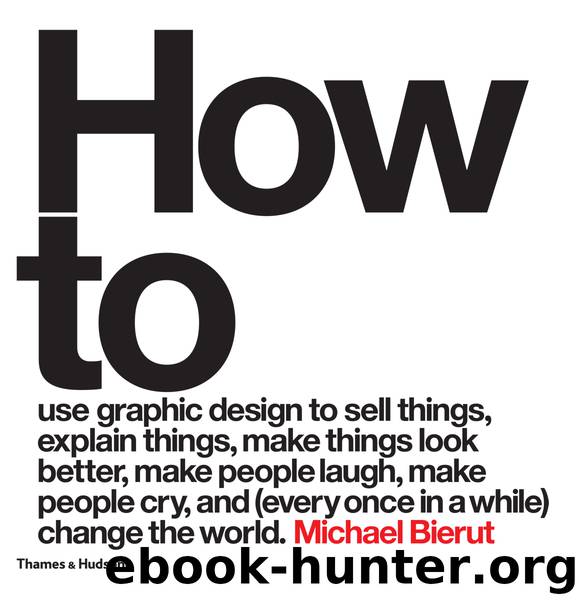How to use graphic design to sell things, explain things, make things look better, make people laugh, make people cry, and (every once in a while) change the world by Bierut Michael

Author:Bierut, Michael
Language: eng
Format: epub
Publisher: Thames & Hudson, Ltd.
Published: 2015-11-30T12:12:39+00:00
00882_Bierut_CS5.5_PENTAGRAM_02.indd 160 30/04/2015 14:0
00882_Bierut_CS5.5_PENTAGRAM_02.indd 161 30/04/2015 14:0
162 The New York Times Building 00882_Bierut_CS5.5_PENTAGRAM_02.indd 162 30/04/2015 14:0
00882_Bierut_CS5.5_PENTAGRAM_02.indd 163 163 30/04/2015 14:0
00882_Bierut_CS5.5_PENTAGRAM_02.indd 164 30/04/2015 14:0
How to make a museum mad Museum of Arts and Design Opposite Our identity for the Museum of Arts and Design generated a new graphic language for its new home. Above left Edward Durell Stone’s building at 2 Columbus Circle was one of New York’s most polarizing pieces of architecture. Above right Brad Cloepfil’s controversial redesign transformed a dark warren of rooms into an interconnected series of light-filled spaces. The Museum of Arts and Design had a long-running identity crisis. Founded in 1956 as the Museum of Contemporary Crafts, it renamed itself the American Craft Museum in 1986. In 2002, it changed its name yet again, to the Museum of Arts and Design, MAD for short. Despite the nifty acronym, five years later most people still hadn’t heard of it. But that was about to change. On Columbus Circle, where Broadway, 59th Street, and Central Park West intersect to form an awkward square, stood a peculiar structure. Completed in 1964 and designed by Edward Durell Stone as a museum for the collection of grocery-store heir Huntington Hartford, it was described by critic Ada Louise Huxtable as a “die-cut Venetian palazzo on lollipops.” Hartford’s museum lasted only five years. The orphaned building reverted to the city. In 2002, it was offered to the Museum of Arts and Design. It needed work. Architect Brad Cloepfil proposed a deft transformation, cutting a continuous slot that snaked through its floors, ceilings, and walls. We were asked to create a new graphic identity to mark the rebirth. Inspired by Cloepfil’s design, I proposed a logo similarly made of a single line. It was one of the best ideas I ever had. There was only one problem: it didn’t work, at least not with the name MAD. Luckily, I had heard that some people thought the acronym was undignified. I seized on this and proposed a name change to A+D, which emphasized the institution’s areas offocus and, conveniently, could be made to work with my idea. I presented this in a series of meetings, armed with ever more elaborate prototypes. But I could not make the sale. If you have a great idea but can’t make it work, it isn’t a great idea. That night, I stared at the site. MAD would face the only complete traffic circle in Manhattan. Squares and circles. I looked at the three letters in the name. Could squares and circles be found there as well? The answer was yes. The simplest geometry solved the problem. No longer necessary were straining machinations and feverish salesmanship. Here was that rare thing: a solution that sold itself. It was approved unanimously at the next meeting. 00882_Bierut_CS5.5_PENTAGRAM_02.indd 165 165 30/04/2015 14:0
Download
This site does not store any files on its server. We only index and link to content provided by other sites. Please contact the content providers to delete copyright contents if any and email us, we'll remove relevant links or contents immediately.
Wonder by R.J. Palacio(8431)
Mastering Adobe Animate 2023 - Third Edition by Joseph Labrecque(3721)
Unlabel: Selling You Without Selling Out by Marc Ecko(3574)
Ogilvy on Advertising by David Ogilvy(3485)
Hidden Persuasion: 33 psychological influence techniques in advertising by Marc Andrews & Matthijs van Leeuwen & Rick van Baaren(3454)
Drawing Cutting Edge Anatomy by Christopher Hart(3440)
The Pixar Touch by David A. Price(3347)
POP by Steven Heller(3298)
The Code Book by Simon Singh(3057)
The Art of War Visualized by Jessica Hagy(2932)
Slugfest by Reed Tucker(2924)
The Curated Closet by Anuschka Rees(2899)
Rapid Viz: A New Method for the Rapid Visualization of Ideas by Kurt Hanks & Larry Belliston(2815)
Stacked Decks by The Rotenberg Collection(2796)
365 Days of Wonder by R.J. Palacio(2738)
The Wardrobe Wakeup by Lois Joy Johnson(2717)
Keep Going by Austin Kleon(2682)
Tattoo Art by Doralba Picerno(2583)
Tell Me More by Kelly Corrigan(2579)
